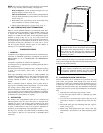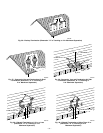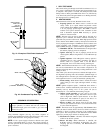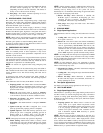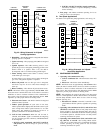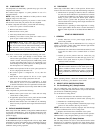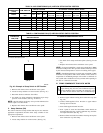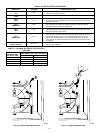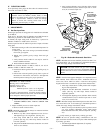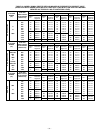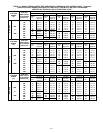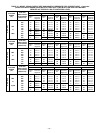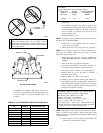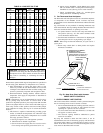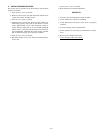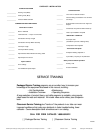
B. Set Temperature Rise
CAUTION: Temperature rise must be within limits
specified on unit rating plate. Recommended operation is
at midpoint of rise or above. Failure to follow this caution
may result in condensing or overheating the heat ex-
changers.
Furnace must operate within range of temperature rise specified on
the unit rating plate. Determine air temperature rise as follows:
1. Place thermometers in return and supply ducts as near
furnace as possible. Be sure thermometers do not see heat
exchanger so that radiant heat does not affect readings. This
practice is particularly important with straight-run ducts.
2. When thermometer readings stabilize, subtract return-air
temperature from supply-air temperature to determine air
temperature rise.
NOTE: Temperature rise can be determined for low-fire opera-
tion by placing setup switch SW-2 on control center in ON
position. For high-heat operation, place setup switch SW-2 in OFF
position and jumper R-W2 on control center. DO NOT forget to
return setup switch to OFF position and remove R-W2 jumper
upon completion of testing. (See Fig. 25 for switch and terminal
location.)
3. This furnace is capable of automatically providing proper
airflow to maintain the temperature rise within the range
specified on unit rating plate. If temperature rise is outside
this range, proceed as follows:
a. Check gas input for low- and high-heat operation.
b. Check derate for altitude if applicable.
c. Check all return and supply ducts for excessive restric-
tions causing static pressure greater than 0.5-in. wc.
d. Ensure bypass humidifier switch (BPH) setup switch
SW-3 on control center is in ON position when a bypass
humidifier is used. (See Fig. 25 for switch location.)
e. Check Troubleshooting Guide for Variable-Speed
2-Stage Electronic Condensing Furnaces.
C. Set Thermostat Heat Anticipator
The thermostat heat anticipator must be set to match the amp draw
of components in the R-W/W1 circuit. Accurate amp draw
measurements can be obtained at the thermostat subbase terminals
R and W.
Fig. 50 illustrates an easy method of obtaining thermostat amp
draw measurements. The amp reading should be taken after blower
motor has started and furnace is operating in low heat.
1. To operate furnace in low heat, turn setup switch SW-2 to
ON position (See Fig. 25) and connect ammeter leads
across thermostat subbase R-W.
2. See thermostat manufacturer’s instructions for adjusting the
heat anticipator and for varying heating cycle length.
NOTE: When using an electronic thermostat, set cycle rate for 3
cycles per hr.
3. Return setup switch SW-2 to OFF position and replace
thermostat on subbase.
CHECK SAFETY CONTROLS
I. CHECK PRIMARY LIMIT CONTROL
This control shuts off the combustion control system and energizes
the air-circulating blower motor if furnace overheats.
1. The recommended method of checking this limit control is
to gradually block off return air after furnace has been
operating for a period of at least 5 minutes.
2. As soon as limit control has shut off burners, a 33 fault code
will appear on control center.
3. The return-air opening should be unblocked to permit
normal air circulation.
By using this method to check the limit control, it can be
established that the limit is functioning properly and the furnace
will operate safely if there is a restricted return-air supply or motor
failure. If the limit control does not function during this test, the
cause must be determined and corrected.
TABLE 14—GAS RATE CU FT/HR
SECONDS
FOR 1
REVOLUTION
SIZE OF TEST DIAL
SECONDS
FOR 1
REVOLUTION
SIZE OF TEST DIAL
1
cu ft
2
cu ft
5
cu ft
1
cu ft
2
cu ft
5
cu ft
10
11
12
13
14
360
327
300
277
257
720
655
600
555
514
1800
1636
1500
1385
1286
50
51
52
53
54
72
71
69
68
67
144
141
138
136
133
360
355
346
340
333
15
16
17
18
19
240
225
212
200
189
480
450
424
400
379
1200
1125
1059
1000
947
55
56
57
58
59
65
64
63
62
61
131
129
126
124
122
327
321
316
310
305
20
21
22
23
24
180
171
164
157
150
360
343
327
313
300
900
857
818
783
750
60
62
64
66
68
60
58
56
54
53
120
116
112
109
106
300
290
281
273
265
25
26
27
28
29
144
138
133
129
124
288
277
267
257
248
720
692
667
643
621
70
72
74
76
78
51
50
48
47
46
103
100
97
95
92
257
250
243
237
231
30
31
32
33
34
120
116
113
109
106
240
232
225
218
212
600
581
563
545
529
80
82
84
86
88
45
44
43
42
41
90
88
86
84
82
225
220
214
209
205
35
36
37
38
39
103
100
97
95
92
206
200
195
189
185
514
500
486
474
462
90
92
94
96
98
40
39
38
38
37
80
78
76
75
74
200
196
192
188
184
40
41
42
43
44
90
88
86
84
82
180
176
172
167
164
450
439
429
419
409
100
102
104
106
108
36
35
35
34
33
72
71
69
68
67
180
178
173
170
167
45
46
47
48
49
80
78
76
75
73
160
157
153
150
147
400
391
383
375
367
110
112
116
120
33
32
31
30
65
64
62
60
164
161
155
150
Fig. 50—Amp Draw Check with Ammeter
A96316
R Y W G
10 TURNS
THERMOSTAT SUBBASE
TERMINALS WITH
THERMOSTAT REMOVED
(ANITICIPATOR, CLOCK, ETC.,
MUST BE OUT OF CIRCUIT.)
HOOK-AROUND
AMMETER
EXAMPLE:
5.0 AMPS ON AMMETER
10 TURNS AROUND JAWS
=
0.5 AMPS FOR THERMOSTAT
ANTICIPATOR SETTING
FROM UNIT 24-V
CONTROL TERMINALS
—42—



